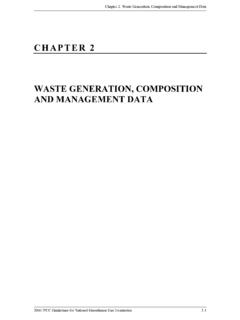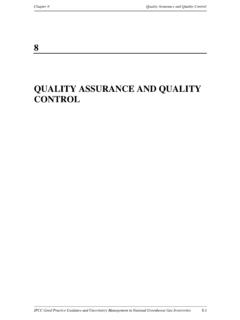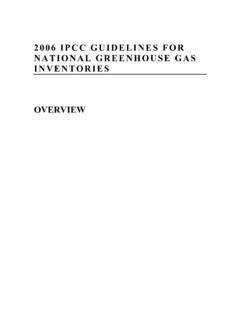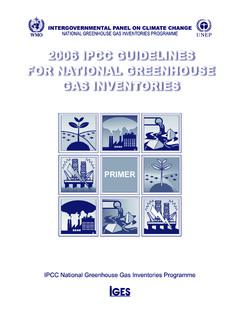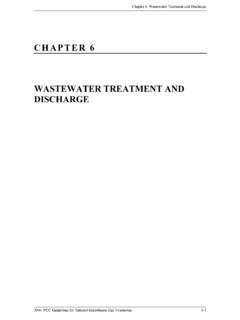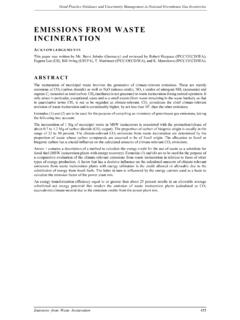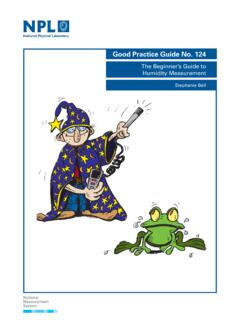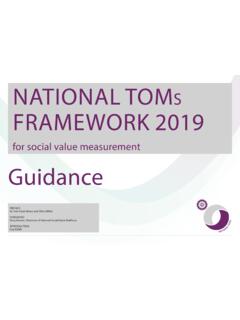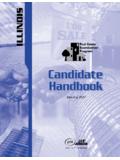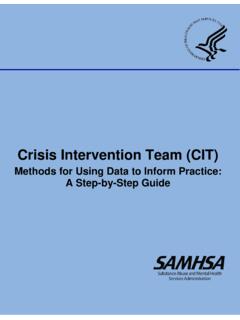Transcription of CHAPTER 2 APPROACHES TO DATA COLLECTION - IGES
1 CHAPTER 2: APPROACHES to data COLLECTION 2006 IPCC Guidelines for National Greenhouse Gas Inventories CHAPTER 2 APPROACHES TO data COLLECTION Volume 1: General Guidance and Reporting 2006 IPCC Guidelines for National Greenhouse Gas Inventories Authors Justin Goodwin (UK), Mike Woodfield (UK) Mirghani Ibnoaf (Sudan), Matthias Koch (Germany), and Hong Yan (China) Contributing Authors Christopher Frey (USA), Rosemary Montgomery (United Nation Statistical Division), Tinus Pulles (Netherlands), Deborah Ottinger Schaeffer (USA), and Karen Treanton (IEA) CHAPTER 2: APPROACHES to data COLLECTION 2006 IPCC Guidelines for National Greenhouse Gas Inventories Contents 2 APPROACHES to data COLLECTION Introduction .. Collecting data .. Gathering existing data .. Generating new data .. Adapting data for inventory use .. Emission factors and direct measurement of emissions .. Activity data .. References .. Annex A protocol for expert elicitation.
2 Annex General guidance on performing surveys .. Figures Figure Process for including data in the EFDB .. Tables Table Generic elements of a measurement programme .. Table Potential sources of literature data .. Table Standard measurement methods for exhaust gas .. Table Example of documentation of expert judgement .. Boxes Box Example of using alternative data to approximate activity data .. Box The difference between census and survey data .. Volume 1: General Guidance and Reporting 2006 IPCC Guidelines for National Greenhouse Gas Inventories 2 APPROACHES TO data COLLECTION INTRODUCTION Data1 COLLECTION is an integral part of developing and updating a greenhouse gas inventory. Formalised data COLLECTION activities should be established, adapted to countries national circumstances, and reviewed periodically as a part of implementing good practice. In most cases generating new source data will be limited by the resources available and prioritisation will be needed, taking account the results of key category analysis set out in CHAPTER 4, Methodological Choice and Identification of Key Categories.
3 data COLLECTION procedures are necessary for finding and processing existing data , ( , data that are compiled and stored for other statistical uses than the inventory), as well as for generating new data by surveys or measurement campaigns. Other activities include maintaining data flows, improving estimates, generating estimates for new categories and/or replacing existing data sources when those currently used are no longer available. The methodological principles of data COLLECTION that underpin good practice are the following: Focus on the COLLECTION of data needed to improve estimates of key categories which are the largest, have the greatest potential to change, or have the greatest uncertainty. Choose data COLLECTION procedures that iteratively improve the quality of the inventory in line with the data quality objectives. Put in place data COLLECTION activities (resource prioritisation, planning, implementation, documentation etc.)
4 That lead to continuous improvement of the data sets used in the inventory. Collect data /information at a level of detail appropriate to the method used. Review data COLLECTION activities and methodological needs on a regular basis, to guide progressive, and efficient, inventory improvement. Introduce agreements with data suppliers to support consistent and continuing information flows. This CHAPTER provides general guidance for collecting existing national/international data and new data . The material is intended both for countries establishing a data COLLECTION strategy for the first time and for countries with established data COLLECTION procedures. It is applicable to emission factor, activity, and uncertainty data COLLECTION . It covers: Developing a data COLLECTION strategy to meet data quality objectives regarding timeliness, and also consistency, completeness, comparability, accuracy, and transparency using guidance provided in CHAPTER 6, QA/QC and Verification, of this volume, data acquisition activities including generating new source data , dealing with restricted data and confidentiality, and using expert judgement, Turning the raw data into a form that is useful for the inventory.
5 Advice related to selecting emission factors focuses on understanding and generating measured data as well as addressing where to find and when to use default factors. Guidance on activity data focuses on generating and using new census & survey data as well as providing guidance on the use of existing international data sets. The CHAPTER draws on information from a range of institutions and where possible additional documents have been identified and referenced so that users can find more detailed information. Sector specific data COLLECTION issues - like selecting the appropriate activity data for a particular category of emissions by sources and removals by sinks - are described in the sector specific Volumes 2-5. COLLECTING data This section provides general guidance for collecting existing data , generating new data , and adapting data for inventory use. The guidance is applicable to emission factors, activity and uncertainty data COLLECTION .
6 It 1 data can be defined as factual information ( , measurements or statistics) used as a basis for reasoning, discussion, or calculation. data COLLECTION is the activity of acquiring and compiling information from different sources. CHAPTER 2: APPROACHES to data COLLECTION 2006 IPCC Guidelines for National Greenhouse Gas Inventories discusses separately specific issues relating to new data and existing data . Specific guidance for the COLLECTION /calculation of emission factors and the COLLECTION of activity and uncertainty data is provided subsequently. Throughout the data COLLECTION activities the inventory compiler should maintain QA/QC records about the data collected according to the guidance provided in CHAPTER 6 of Volume 1. While collecting data it is good practice to be aware of future data COLLECTION needs. Maintaining supply of inventory data It is good practice to engage data suppliers in the process of inventory compilation and improvement by involving them in activities such as: Offering an initial estimate for the category, pointing out the potentially high uncertainties and inviting potential data suppliers to collaborate in improving estimates, Scientific or statistical workshops on the inventory inputs and outputs, Specific contracts or agreements for regular data supply, Regular/annual informal updates on the methods that use their data , Establishment of terms of reference or memoranda of understanding for government and/or trade organisations providing data to clarify what is needed for the inventory, how it is derived and provided to the inventory compiler and when.
7 These activities will help to ensure that the most appropriate data are available for the inventory and that the data are properly understood by the inventory compiler. It will also help to establish links to data providing organisations. Where appropriate, it may be useful to explore existing or new legal arrangements as means of guaranteeing the delivery of data to the inventory. Restricted data and confidentiality data providers might restrict access to information because it is confidential, unpublished, or not yet finalised. Typically, this is a mechanism to prevent inappropriate use of the data , unauthorised commercial exploitation, or sensitivity to possible imperfections in the data . Sometimes, however, the organisation simply does not have the resources required to compile and check the data . It is advisable, where possible, to cooperate with data providers to find solutions to overcome their concerns by: explaining the intended use of the data , agreeing, in writing, to the level at which it will be made public, identifying the increased accuracy that can be gained through its use in inventories, offering cooperation to derive a mutually acceptable data sets, and/or giving credit/acknowledgement in the inventory to the data provided.
8 The protection of confidentiality is one of the fundamental principles of a national statistical agency (NSA2 - see: ). NSAs are committed to safeguarding information that plainly reveals the operations, belongings, attitudes or any other characteristics of individual respondents. If respondents are not convinced that the information they provide to the NSA is absolutely confidential, the quality of the information collected may suffer. Detailed individual data must therefore be treated and aggregated so as to draw out the information that is important to the user, without disclosing individual data . This is more likely to be an issue for business statistics, especially where a few companies dominate the sector, than for other data . Sometimes, depending on the size and structure of the original sample, raw data can be aggregated in a way that protects confidentiality and yet produces useful information for emission inventory purposes. If, however, there is a need to preserve confidentiality the NSA, or the body that originally collected the data , are normally the only ones that can carry out this additional treatment of the raw data .
9 Some countries have special arrangements to mask data ( , make data anonymous with respect to companies or facilities) to allow researchers access. Inventory compilers may investigate the possibility of making such arrangements. However, as this reprocessing will be required regularly (annually if possible), a better solution would probably be for NSAs to incorporate this into their own work programmes. While this will require an initial investment in data processing, it will probably be quicker and less expensive in the long run. Once the 2 Any main national official data COLLECTION organisation is referred to here as national statistical agency. Volume 1: General Guidance and Reporting 2006 IPCC Guidelines for National Greenhouse Gas Inventories reprocessing system is set up it can be reused every time the survey is repeated, with low marginal costs.
10 An added advantage is that the information will then be in the public domain so that others can validate the figures reported in the inventories. Many agencies collect ancillary data during operations for other purposes, such as registration of businesses or vehicles, COLLECTION of taxes, granting of licences, allocation of grants and subsidies. Such information is usually also covered by confidentiality clauses. In general, such clauses foresee the use of the data for statistical purposes, and NSAs have the right of access to such data . Often these administrative data form the basis for sample stratification and selection and NSAs will have experience in handling them, perhaps even developing specialist software that allows the required information to be drawn out without breaching the confidentiality rules. For all these reasons, when existing data need to be reprocessed, it is strongly recommended to work together with NSAs or the statistical service of the relevant ministry, not only to protect confidentiality, but also for cost savings.
